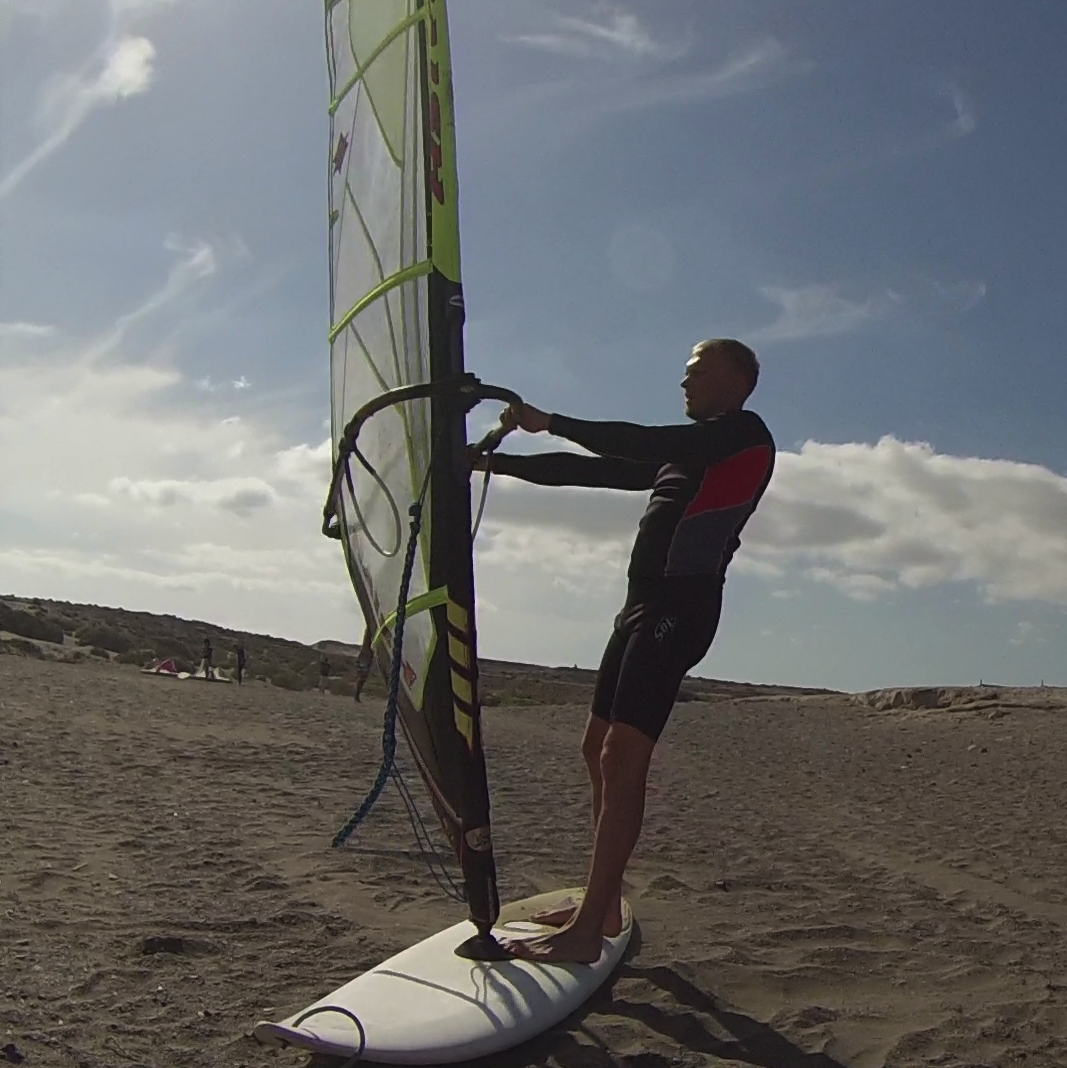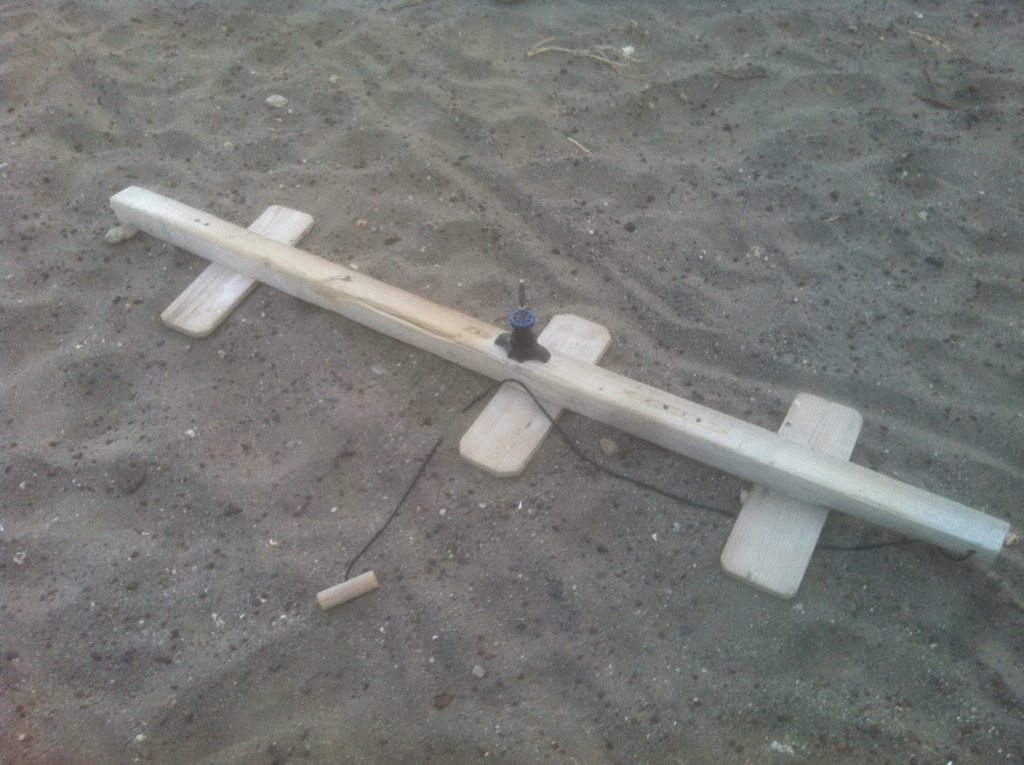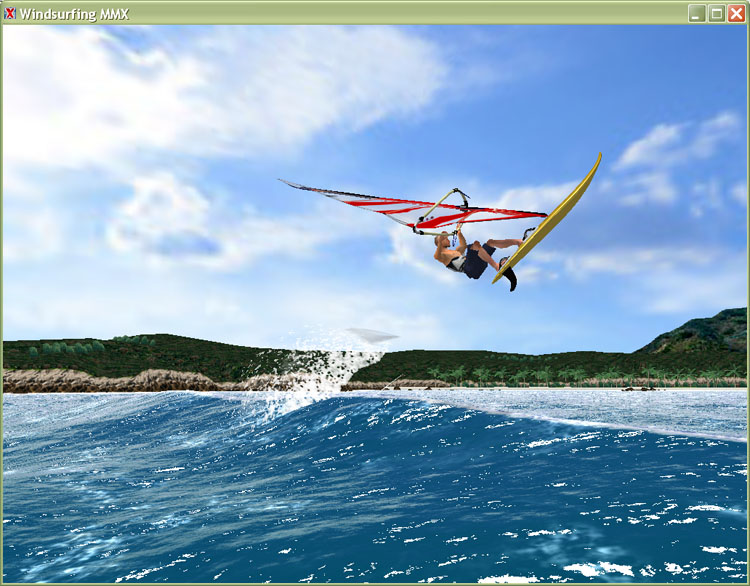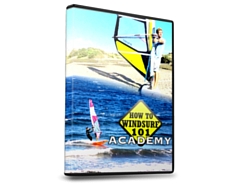Simulator: a device which helps prepare a task or action in an environment in which the consequences of failing to do said task correctly results in little or no repercussion.
In the case of the windsurfing simulator it is any device which allows us to learn a number of manoeuvres on land so that when we get it wrong we dont have to crawl onto the board after falling in and waste energy in the process.
Types of windsurfing simulators
The corpse
Maybe a little too macabre way of calling a retired board. I am referring to an old board that has had one beating too many on the rocks or has gotten delaminated beyond salvation. As soon as it becomes the simulator it is doomed to be used roughly until it breaks apart. It is free to rotate the full 360 degrees over its centre. At the SURF CENTER PLAYA SUR we have drilled a hole into the nose and passed a rope through it to pull the board around when teaching steering, turns or even the effect of lateral waves.
Fin dig
Should we not have an old board at our disposal that we can turn into the beach gimp-board, we can improvise with an intact board and just dig a hole for the fin so that it doesn’t have to take the weight of the student and risk breaking off. The downside is that it can only be rotated around the fin, meaning that the student has to get off each time the course is modified.
The beam
This consists only of a beam with a mast-foot attached to it and some lateral supports to keep it upright.
This device is good only for one thing: getting the feeling of finding the equilibrium between the shift of weight by leaning back with the body and the pull of the sail.
The aim for the student is to remain on the beam by opening and closing the sail in the correct amounts in order to learn to not compensate the shift in bodyweight by moving the feet but only with the sail power.
The pontoon
I got this idea from Will Rogers. I haven’t tried this one as I have only taught on the sea with waves and a pontoon is just not viable.
The idea is to have a platform on the water that can rotate over its centre (so the board can also) and lay the board on it so that it has more stability.
The anchored vessel
This one comes from Colin Walters. Much like the pontoon but taking it a step further by taking a functioning board and tethering it to the bottom in shallow water through the daggerboard slot. I haven’t tried this one either for the same reason as mentioned before but I assume it simulates the windsurfing sensation without the inconvenience of drifting downwind and having to walk back again.
The high tech simulator
A state of the art device which takes somewhat more dedication and handicraft. It is basically a board strapped onto a platform that can rotate 360° over a pivot point. It is a fairly good representation of how a windsurfer reacts to the different sail positions and pressure increments.
As we can see in the video, the simulator rotates very quickly and at the slightest alteration. Whilst this may be great training for someone that is slightly advanced past your basic sailing back and forth routine, for a beginner this can be very frustrating since they don’t have the feeling built up in order to react correctly in time. A solution to this is to install a set of springs or dampeners to the rotation mechanism so the kit doesn’t overrotate constantly and you don’t have to be so precise with the sail control. Another option is to use small sails (less power) or sails with a low centre of power.
For guide how to build it check out the post by Andy Reed or the one by Colin Walters.
The only downside to this construction (considering the dampening to the rotation is in place) is that it cannot be used in locations where sand flies around all over the place as the grains will obstruct the rotational workings of the simulator. However for other locations this is fine.
Frontloop Simulator
The VDWS had this one on display at the Boot.
I like this one. I haven’t had a go on this but it looks like loads of fun. As to how well it simulates reality, I believe the only thing it can prepare you for is the sensation of rotating forwards so that it doesn’t surprise you the first time you actually dare to go for it. As I don’t know how this one works I can’t tell whether the rotation is induced by the weight displacement or the pulling of the back hand or both (or neither).
As I said, I have no idea as to how accurate it is but I guess that if they went through the hassle of constructing something so elaborate, it must be for a reason.
Waterstart Simulator
Just so you don’t drift downwind during the hours and hours of waterstart training, how about an anchor?
The game
Much like the flight simulator for airplane geeks, this game is fun and an accurate enough representation of the real deal. Naturally the graphics are not on the standard of say the latest Call of Duty game but it is definitely entertaining. I have only played the demo version for a short while meaning the only thing I got to try was jybes, tacks, cutbacks, goitas and the occasional frontloop but I gotta say that it was entertaining. Once you get the hang of it you might use it to hype yourself up for a session during those last tiresome minutes at the office.
The guys at Windsurfing MMX have done a great job so if you get the chance check it out here.
Summary
As useful as simulators are to get across the basics of windsurfing or specific moves I do think they are overused as the only real way to learn the art of windsurfing is to do it in the real world.
If you think this post is incomplete or inaccurate let me know in the comments and I will update whatever is applicable.










Does anybody have a nice guide (like a pdf) with the instructions to build a windsurf simulator?
A diagram representing the land based windsurfing simulator using the CATIA V5 software allowing the simulation of the windsurfer in action. The system is com-prised of several elements : an electronic weightlifting bar fixing the constraining weight applied to the wishbone by a steel cable ; the electromyographic analysis system ; a fixed base for the mat. Results of the electromyography depending on the use of 15 kg for the forearm and the leading hand (A) and the forearm of the following hand (B). The values where the muscular activity is at minimum are represented in a percentage (%) depending on: the diameters of the wishbone (28 mm, 30 mm, 32 mm), the position of the hands (leading, following) in pronation (P) or in supination (S), in order to test the four postures (SS, PP, SP, PS).